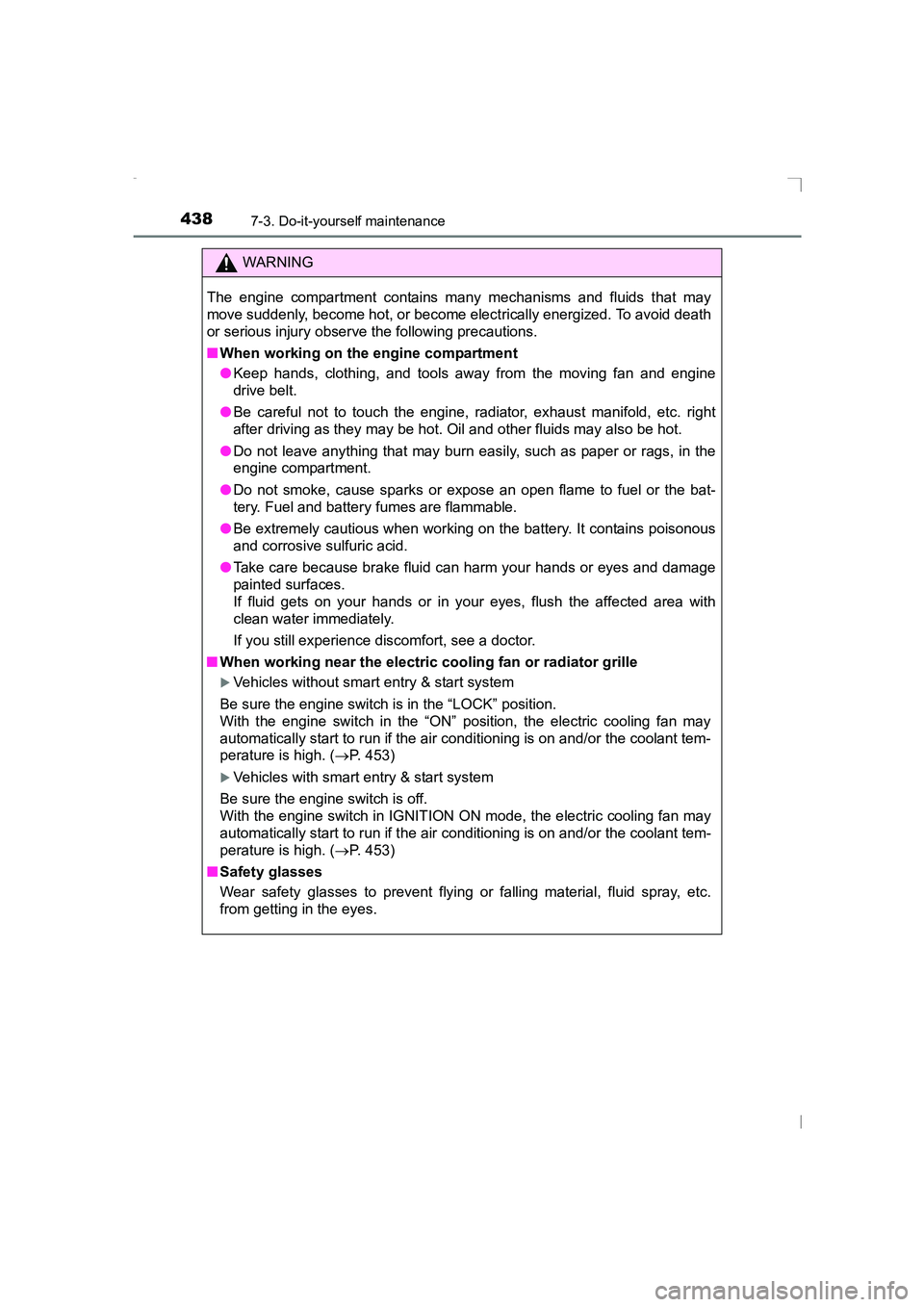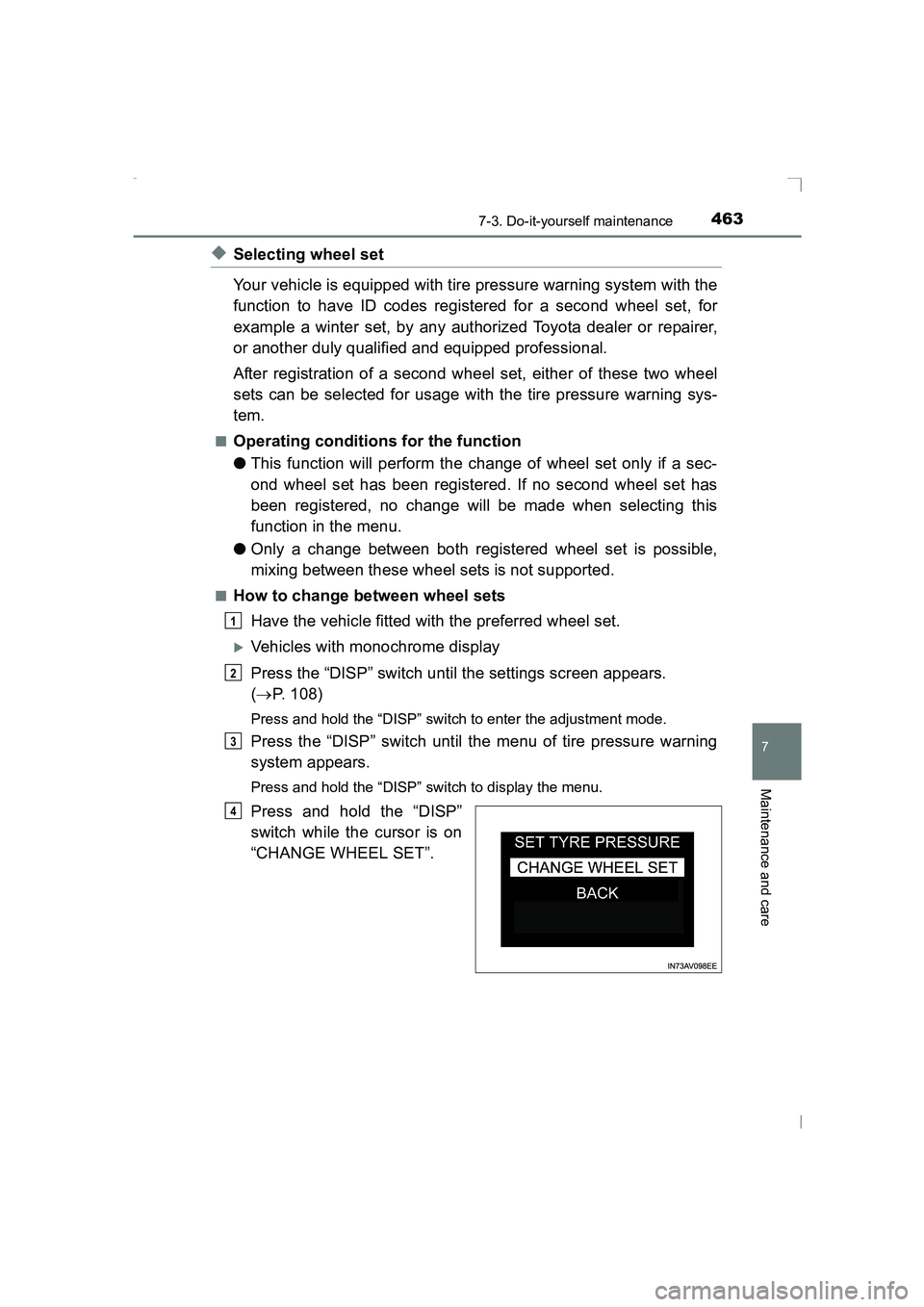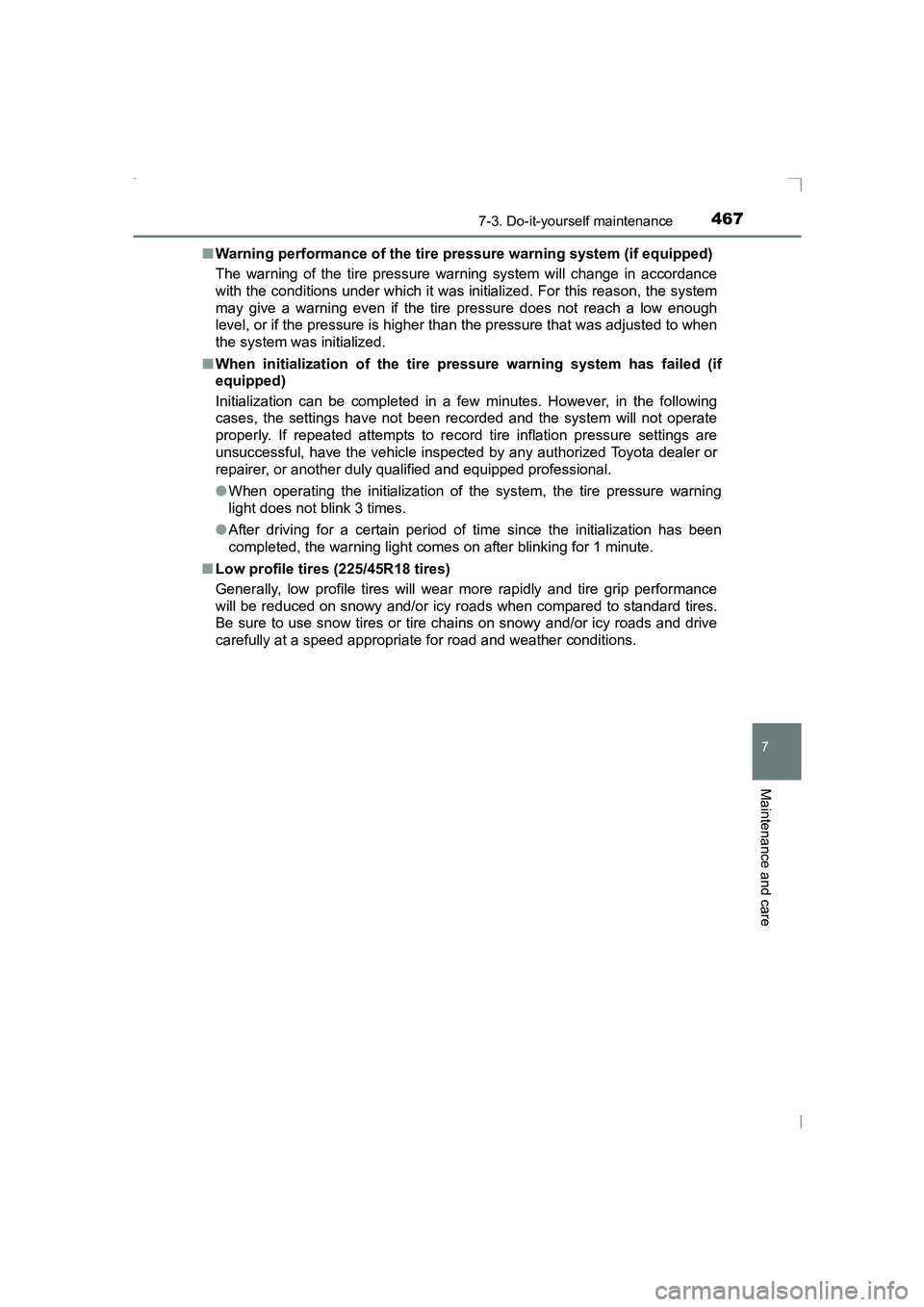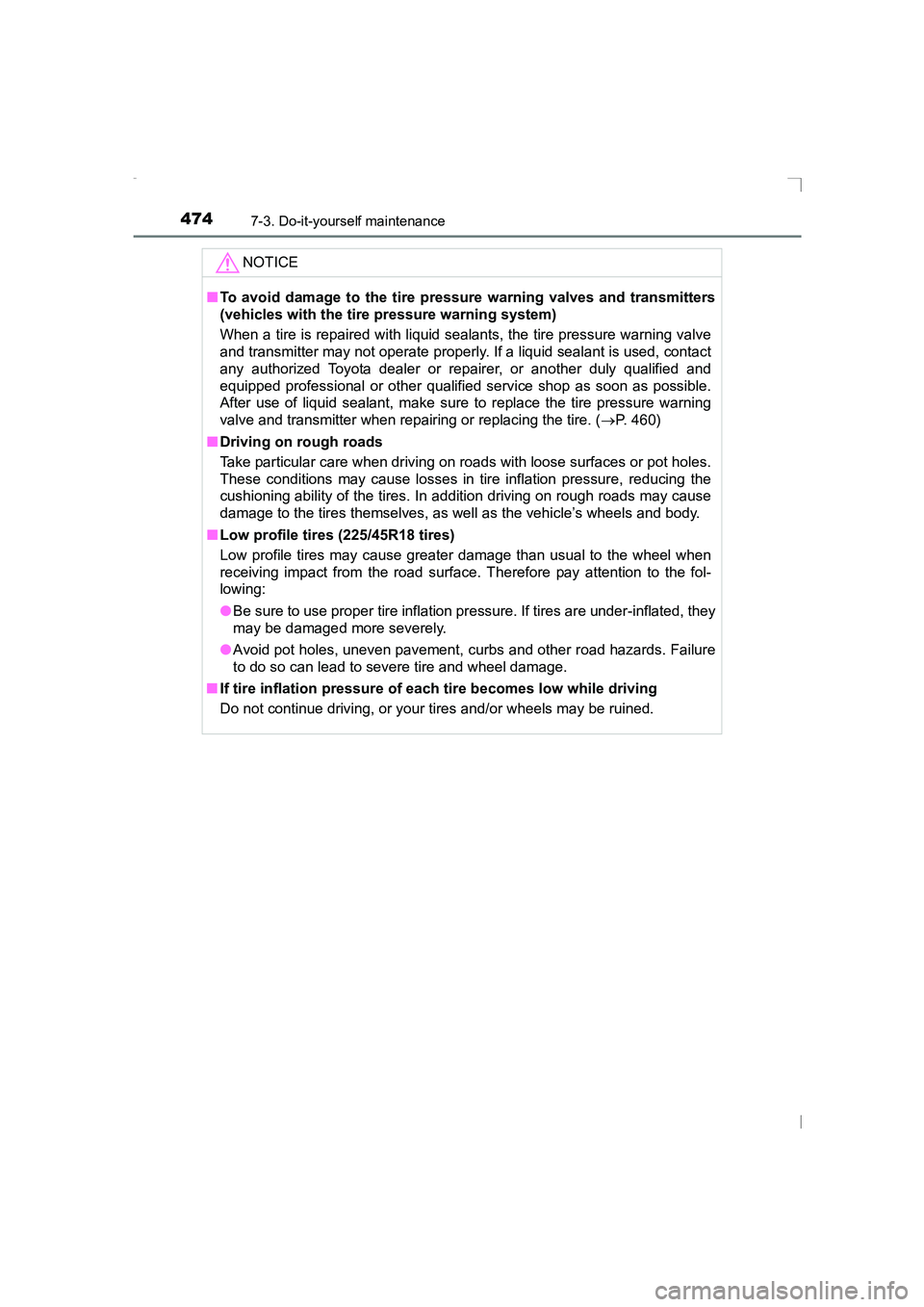Page 436 of 648

4367-3. Do-it-yourself maintenance
AVENSIS_OM_OM20C20E_(EE)
Do-it-yourself ser vice precautions
If you perform maintenance yourself, be sure to follow the cor-
rect procedures as given in these sections.
ItemsParts and tools
Battery condition
(→ P. 453)•Warm water• Baking soda•Grease
• Conventional wrench (for terminal clamp bolts)
Engine coolant
level ( →P. 451)
�XGasoline engine
• Toyota Super Long Life Coolant or similar high qual-
ity ethylene glycol based non-silicate, non-amine,
non-nitrite and non-borate c oolant with long-life
hybrid organic acid technology. Toyota Super Long
Life Coolant is pre-mixed with 50% coolant and 50%
deionized water.
• Funnel (used only for adding coolant)
�XDiesel engine
• “Toyota Genuine Premium Long Life Coolant 1WW/ 2WW” or equivalent. “Toyota Genuine Premium Long
Life Coolant 1WW/2WW” concentrated product
always needs to be mixed as 50% coolant and 50%
deionized water.
Contact any authorized Toyota dealer or repairer, or
another duly qualified and equipped professional, for
usage of any other approved engine coolant of
matching quality.
• Funnel (used only for adding coolant)
Engine oil level
(→ P. 446)
�XGasoline engine
• Toyota Genuine Motor Oil or equivalent
• Rag or paper towel, funnel (used only for adding oil)
�XDiesel engine
• “Toyota Genuine Motor Oil 5W-30 Premium Fuel
Economy for 1WW/2WW engines”.
Contact any authorized Toyota dealer or repairer, or
another duly qualified and equipped professional, for
usage of any other approved engine oil of matching
quality.
• Rag or paper towel, funnel (used only for adding oil)
Fuses ( →P. 485)• Fuse with same amperage rating as original
AVENSIS_OM_OM20C20E_(EE).book Page 436 Thursday, January 29, 2015 1:47 PM
Page 438 of 648

4387-3. Do-it-yourself maintenance
AVENSIS_OM_OM20C20E_(EE)
WARNING
The engine compartment contains many mechanisms and fluids that may
move suddenly, become hot, or become electrically energized. To avoid death
or serious injury observe the following precautions.
■ When working on the engine compartment
●Keep hands, clothing, and tools away from the moving fan and engine
drive belt.
● Be careful not to touch the engine, radiator, exhaust manifold, etc. right
after driving as they may be hot. Oil and other fluids may also be hot.
● Do not leave anything that may burn easily, such as paper or rags, in the
engine compartment.
● Do not smoke, cause sparks or expose an open flame to fuel or the bat-
tery. Fuel and battery fumes are flammable.
● Be extremely cautious when working on the battery. It contains poisonous
and corrosive sulfuric acid.
● Take care because brake fluid can harm your hands or eyes and damage
painted surfaces.
If fluid gets on your hands or in your eyes, flush the affected area with
clean water immediately.
If you still experience discomfort, see a doctor.
■ When working near the electric cooling fan or radiator grille
�XVehicles without smart entry & start system
Be sure the engine switch is in the “LOCK” position.
With the engine switch in the “ON” position, the electric cooling fan may
automatically start to run if the air conditioning is on and/or the coolant tem-
perature is high. ( →P. 453)
�XVehicles with smart entry & start system
Be sure the engine switch is off.
With the engine switch in IGNITION ON mode, the electric cooling fan may
automatically start to run if the air conditioning is on and/or the coolant tem-
perature is high. ( →P. 453)
■ Safety glasses
Wear safety glasses to prevent flying or falling material, fluid spray, etc.
from getting in the eyes.
AVENSIS_OM_OM20C20E_(EE).book Page 438 Thursday, January 29, 2015 1:47 PM
Page 453 of 648
4537-3. Do-it-yourself maintenance
AVENSIS_OM_OM20C20E_(EE)
7
Maintenance and care
Check the radiator, condenser and intercooler (diesel engine) and
clear any foreign objects.
If any of the above parts are extremely dirty or you are not sure of
their condition, have your vehicle checked by any authorized Toyota
dealer or repairer, or another duly qualified and equipped profes-
sional.
Check the battery as follows.
■Caution symbol
The meanings of each caution symbol on the top of the battery are
as follows:
Radiator, condenser and intercooler
WARNING
■ When the engine is hot
Do not touch the radiator, condenser or intercooler, as they may be hot and
cause serious injuries, such as burns.
Battery
No smoking, no naked
flames, no sparksBattery acid
Shield eyesNote operating
instructions
Keep away from chil-
drenExplosive gas
AVENSIS_OM_OM20C20E_(EE).book Page 453 Thursday, January 29, 2015 1:47 PM
Page 463 of 648

4637-3. Do-it-yourself maintenance
AVENSIS_OM_OM20C20E_(EE)
7
Maintenance and care
◆Selecting wheel set
Your vehicle is equipped with tire pressure warning system with the
function to have ID codes registered for a second wheel set, for
example a winter set, by any authorized Toyota dealer or repairer,
or another duly qualified and equipped professional.
After registration of a second wheel set, either of these two wheel
sets can be selected for usage with the tire pressure warning sys-
tem.
■Operating conditions for the function
●This function will perform the change of wheel set only if a sec-
ond wheel set has been registered. If no second wheel set has
been registered, no change will be made when selecting this
function in the menu.
● Only a change between both registered wheel set is possible,
mixing between these wheel sets is not supported.
■How to change between wheel sets
Have the vehicle fitted with the preferred wheel set.
�XVehicles with monochrome display
Press the “DISP” switch until the settings screen appears.
(→ P. 108)
Press and hold the “DISP” switch to enter the adjustment mode.
Press the “DISP” switch until the menu of tire pressure warning
system appears.
Press and hold the “DISP” switch to display the menu.
Press and hold the “DISP”
switch while the cursor is on
“CHANGE WHEEL SET”.
1
2
3
4
AVENSIS_OM_OM20C20E_(EE).book Page 463 Thursday, January 29, 2015 1:47 PM
Page 467 of 648

4677-3. Do-it-yourself maintenance
AVENSIS_OM_OM20C20E_(EE)
7
Maintenance and care
■Warning performance of the tire pressure warning system (if equipped)
The warning of the tire pressure warning system will change in accordance
with the conditions under which it was initialized. For this reason, the system
may give a warning even if the tire pressure does not reach a low enough
level, or if the pressure is higher than the pressure that was adjusted to when
the system was initialized.
■ When initialization of the tire pressure warning system has failed (if
equipped)
Initialization can be completed in a few minutes. However, in the following
cases, the settings have not been recorded and the system will not operate
properly. If repeated attempts to record tire inflation pressure settings are
unsuccessful, have the vehicle inspected by any authorized Toyota dealer or
repairer, or another duly qualified and equipped professional.
●When operating the initialization of the system, the tire pressure warning
light does not blink 3 times.
● After driving for a certain period of time since the initialization has been
completed, the warning light comes on after blinking for 1 minute.
■ Low profile tires (225/45R18 tires)
Generally, low profile tires will wear more rapidly and tire grip performance
will be reduced on snowy and/or icy roads when compared to standard tires.
Be sure to use snow tires or tire chains on snowy and/or icy roads and drive
carefully at a speed appropriate for road and weather conditions.
AVENSIS_OM_OM20C20E_(EE).book Page 467 Thursday, January 29, 2015 1:47 PM
Page 474 of 648

4747-3. Do-it-yourself maintenance
AVENSIS_OM_OM20C20E_(EE)NOTICE
■
To avoid damage to the tire pressure warning valves and transmitters
(vehicles with the tire pressure warning system)
When a tire is repaired with liquid sealants, the tire pressure warning valve
and transmitter may not operate properly. If a liquid sealant is used, contact
any authorized Toyota dealer or repairer, or another duly qualified and
equipped professional or other qualified service shop as soon as possible.
After use of liquid sealant, make sure to replace the tire pressure warning
valve and transmitter when repairing or replacing the tire. ( →P. 460)
■ Driving on rough roads
Take particular care when driving on roads with loose surfaces or pot holes.
These conditions may cause losses in tire inflation pressure, reducing the
cushioning ability of the tires. In addition driving on rough roads may cause
damage to the tires themselves, as well as the vehicle’s wheels and body.
■ Low profile tires (225/45R18 tires)
Low profile tires may cause greater damage than usual to the wheel when
receiving impact from the road surface. Therefore pay attention to the fol-
lowing:
●Be sure to use proper tire inflation pressure. If tires are under-inflated, they
may be damaged more severely.
● Avoid pot holes, uneven pavement, curbs and other road hazards. Failure
to do so can lead to severe tire and wheel damage.
■ If tire inflation pressure of each tire becomes low while driving
Do not continue driving, or your tires and/or wheels may be ruined.
AVENSIS_OM_OM20C20E_(EE).book Page 474 Thursday, January 29, 2015 1:47 PM
Page 476 of 648
4767-3. Do-it-yourself maintenance
AVENSIS_OM_OM20C20E_(EE)
WARNING
■ Proper inflation is critical to save tire performance
Keep your tires properly inflated.
If the tires are not properly inflated, the following conditions may occur
which could lead to an accident resulting in death or serious injury:
●Excessive wear
● Uneven wear
● Poor handling
● Possibility of blowouts resulting from overheated tires
● Air leaking from between tire and wheel
● Wheel deformation and/or tire damage
● Greater possibility of tire damage while driving (due to road hazards,
expansion joints, sharp edges in the road, etc.)
NOTICE
■ When inspecting and adjusting tire inflation pressure
Be sure to put the tire valve caps back on.
If a valve cap is not installed, dirt or moisture may get into the valve and
cause an air leak, resulting in decreased tire inflation pressure.
AVENSIS_OM_OM20C20E_(EE).book Page 476 Thursday, January 29, 2015 1:47 PM
Page 480 of 648
4807-3. Do-it-yourself maintenance
AVENSIS_OM_OM20C20E_(EE)
Air conditioning filter
Turn the engine switch to the “LOCK” position (vehicles without
smart entry & start system) or off (vehicles with smart entry & start
system).
Open the glove box. Slide off
the damper.
Push in each side of the glove
box to disconnect the claws.
The air conditioning filter must be changed regularly to maintain
air conditioning efficiency.
Removal method
1
2
3
AVENSIS_OM_OM20C20E_(EE).book Page 480 Thursday, January 29, 2015 1:47 PM